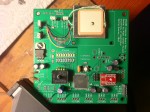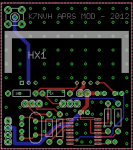For our High Altitude Balloon flights, we use several different custom built systems to relay and/or store data and video from the balloon to the ground. Not every system is used on any given flight, but the systems include:
Primary Telmetry
The primary telemetry uses an FM transmitter in the 900MHz band attached to a voice synthesis chip. Data is sampled from analog to digital converters or pulse counters. This data is then fed in ascii serial format to the voice synthesis chip for transmission. Depending on the data itself (different words have different lengths), and the number of student teams each year, the rate at which a given team would receive a data sample is about once every couple minutes.
Custom & Commercial APRS Trackers
APRS trackers have proven essential in reliably locating the payload during descent and landing. We have used a custom built APRS tracker, my IRIS Transmitter board, as well as commercially available APRS trackers, often in conjunction to provide this essential positioning service.
Video Downlink
The video downlink uses an AM amateur television transmitter in the 434MHz band. Two cameras are in the payload. One points downward, and the other points to the side. A relay switches the video signal to the transmitter between the two on a timed interval. The video downlink also makes use of a video overlay board to display required callsign information as well as GPS data on the received video.
Deprecated: High Speed Digital Telemetry
The high speed digital telemetry has in the past used an AM transmitter in the 434MHz band to downlink RTTY data at 80 baud. This generally allowed for a data sample once every 20-30 seconds. The secondary telemetry has now been outfitted with a 144MHz band transmitter and is now capable of 1200 baud amateur radio packet transmissions. Data samples could be as frequent as every 5 seconds, though the actual rate will be set in the configuration and will be chosen based on the amount of data needed to be downlinked.
 This is the main board for the secondary telemetry system. Visible in this photo are the microcontroller, GPS receiver, barometric pressure sensor, and other support electronics. Yet to be installed are the temperature sensors, flash storage chip, and the radio module.
This is the main board for the secondary telemetry system. Visible in this photo are the microcontroller, GPS receiver, barometric pressure sensor, and other support electronics. Yet to be installed are the temperature sensors, flash storage chip, and the radio module.
 This is the board layout for the 2m Packet transmitter add on. This module will stack on the main board connecting via several headers on the existing board.
This is the board layout for the 2m Packet transmitter add on. This module will stack on the main board connecting via several headers on the existing board.

Hi Nigel – The folks on PSRG repeater suggested I contact you when I mentioned I am researching a project involving high altitude balloons and amateur TV. Your blog is quite interesting! I have a few questions on the hardware setup.
1. How much power are you using for the ATV transmitter?
2. Could you share details on your base station antenna setup to pick up the ATV and telemetry signals from the balloon?
Cheers,
Graham
Graham,
Generally we have the ATV transmitter set for about 1W. We use the VideoLynx VM-70X transmitters, which will do about 5W. However, the extra power isn’t needed, sucks batteries faster, and for us caused issues with the GPS getting a solid lock. For our telemetry transmitters, either APRS on 2M, or RTTY on 70CM, we’re usually running at about 250mW.
On the balloon, for video, we use a moxon, and for telemetry we use either quarter wave ground planes, or a coaxial dipole. On the ground, at the base station we have several about 16′ long yagis with preamps. In the chase vehicles we have some 5 element hand held yagis, but often a mag mount on the car is able to pick it up just fine.
While you’re in the air it’s quite easy to pick up the transmissions. The issue is when the balloon lands, the antenna is usually on or very near the ground and it can be very hard to get a signal if you’re not quite close to it. It’s very important to try and get the last few GPS coordinates before it lands to get an idea.
You should also check out the #highaltitude channel on freenode (IRC), there’s a lot of English folks who do high altitude ballooning there, and I tend to frequent it as well.
Hope that’s helpful!
Nigel
Nigel,
Thanks a lot! that’s less power than I thought, cool. I will check out the channel too, and perhaps catch you on the ATV net.
I want to try using digital tv signal (like DVB-S) high definition video, and also to send control signals up to control servos. Not an easy task, but fun to try :-D
The convenience in that regard is that you’ve got easy access to higher power when transmitting commands from the ground. Which may be necessary, as the antennas on the balloon tend not to be high gain.
I don’t know what you plan to use the servos for, but consider that the payload is likely to be spinning quite a bit. So, in the case of a camera pan/tilt, an up/down servo would be cool to change what you’re looking at, but a side to side servo would be nearly pointless.